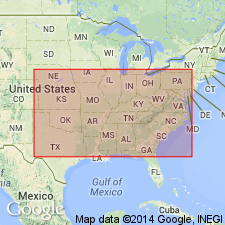
- Usage in publication:
-
- Chickamauga limestone*
- Modifications:
-
- Original reference
- Dominant lithology:
-
- Limestone
- AAPG geologic province:
-
- Appalachian basin
Summary:
Pg. 143, 148; paper read in Dec. 1890. Chickamauga limestone. Blue limestones, 1,200 to 1,800 feet thick, forming middle division of Silurian west of Coosa River, in southern Appalachians, and = Trenton, Chazy, or Maclurea of Smith and Safford. Underlies Rockwood formation and overlies Knox dolomite. On east side of valley [in northwestern Georgia] is almost entirely replaced by Rockmart slates [which also underlie Rockwood formation].
[Named from exposures along Chickamauga Creek, east of Chattanooga, TN, and branches of that creek in Ringgold quadrangle, northwestern GA.]
Source: US geologic names lexicon (USGS Bull. 896, p. 425).

- Usage in publication:
-
- Chickamauga limestone*
- Modifications:
-
- Overview
- AAPG geologic province:
-
- Appalachian basin
Summary:
Chickamauga limestone. Recognized in northern Alabama, northwestern Georgia, eastern Tennessee, and southwestern Virginia. The limestones which in early reports were assembled under name Chickamauga are now [ca. 1936] in most areas divided into several formations (see various State charts) [M.G. Wilmarth, compiler, 1929-1935], but the name is still found useful in some areas. Age is Early, Middle, and Late Ordovician.
Named from exposures along Chickamauga Creek, east of Chattanooga, TN, and branches of that creek in Ringgold quadrangle, northwestern GA.
Source: US geologic names lexicon (USGS Bull. 896, p. 425).
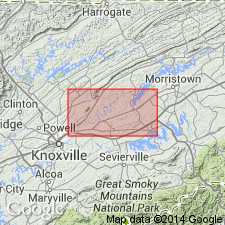
- Usage in publication:
-
- Chickamauga limestone*
- Modifications:
-
- Overview
- AAPG geologic province:
-
- Appalachian basin
Summary:
As originally defined, the Chickamauga limestone included all limestone above the Knox dolomite and beneath the Sevier shale, and in this sense was used on all folios of the southern Appalachian region beginning with Hayes (1894, folio 2) and ending with Butts (1910, folio 175). The Chickamauga as mapped in the folios included equivalents of Kingsport and Mascot formations of the Mascot-Jefferson City zinc district, TN, and in southeastern TN, northwestern GA, and northeastern Al the Newala limestone. With the close of folio mapping in the Appalachians, the name Chickamauga fell into disuse, but it was revived by Rodgers (1953) as a convenient general term for mapping. Unit, as now defined, includes limestone strata of Middle and Late Ordovician age. Unit is thinnest along southeastern edge of Appalachian Valley where it represents a very short time span; it is thickest in sections near the Cumberland Plateau Front where it represents practically all of the Middle and Late Ordovician. Ulrich, about 1900, began dividing Chickamauga limestone into a number of formations. Some of these were described by him in 1911 (GSA Bull, vol. 22); others appeared only as names in correlation charts; and others were names used in note books and unpublished manuscripts. Only a few were ever adequately described, and fewer still have been mapped in detail. In general Ulrich believed that strata included in the Chickamauga consisted of a few widely distributed formations at the base, correlating with formations of Black River or younger units elsewhere, and a great thickness of strata in between not equivalent to any formations elsewhere, the so-called Blount group, wedged in the middle between Chazy and Black River beds. No complete section of the Blount group has ever been found, and at present the idea that such a unit exists has been discarded. Present theory is that a thick limestone sequence, Chickamauga limestone, developed in central and western parts of the Appalachian Valley of east TN and adjacent states and that this grades laterally southeastward into a complementary shale and sandstone sequence, the Sevier shale and higher formations, developed along the southeastern side of the valley. In the Mascot-Jefferson City district, the Chickamauga limestone, or Middle Ordovician sequence, is made up of the Mosheim limestone, Lenoir limestone, and Holston marble.
Source: GNU records (USGS DDS-6; Reston GNULEX).
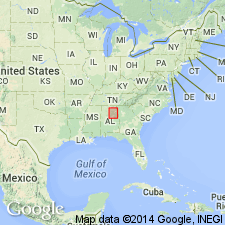
- Usage in publication:
-
- Chickamauga group
- Modifications:
-
- Revised
- AAPG geologic province:
-
- Appalachian basin
Summary:
Raised the rank of the Chickamauga to group status in southeastern TN and AL. Unit is divided into informal units I-IV. The Chickamauga group is of Middle and Late Ordovician age.
Source: GNU records (USGS DDS-6; Reston GNULEX).
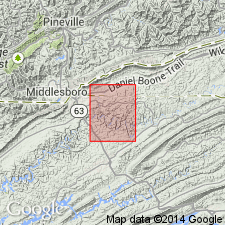
- Usage in publication:
-
- Chickamauga Group*
- Modifications:
-
- Areal extent
- AAPG geologic province:
-
- Appalachian basin
Summary:
In northern TN, rocks of the Middle Ordovician and lower part of the Upper Ordovician are assigned to the Chickamauga Group as used by Swingle (1964, TN Acad. Sci. abs). The Chickamauga Group consists of (ascending) the Dot Formation, Poteet Limestone, Rob Camp Limestone, Martin Creek Limestone, Hurricane Bridge Limestone, Woodway Limestone, Ben Hur Limestone, Hardy Creek Limestone, Eggleston Limestone, Trenton Limestone, and Reedsville Shale. Thickness of the Chickamauga is about 2200 feet.
Source: GNU records (USGS DDS-6; Reston GNULEX).
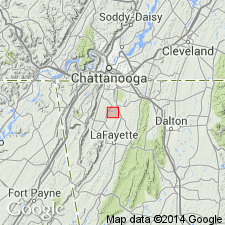
- Usage in publication:
-
- Chickamauga Supergroup
- Modifications:
-
- Revised
- AAPG geologic province:
-
- Appalachian basin
Summary:
Raised the Chickamauga to supergroup status in southeastern TN and northwestern GA. The Chickamauga Supergroup is made up of the Stones River (Pond Spring, Murfreesboro, Ridley, Lebanon, Carters Formations) and Nashville (Hermitage, Cannon, and Catheys Formation) Groups. Unit is change to supergroup to provide maximum flexibility for stratigraphic studies. The Chickamauga Supergroup unconformably overlies the Knox Group and underlies the Upper Ordovician red beds.
Source: GNU records (USGS DDS-6; Reston GNULEX).
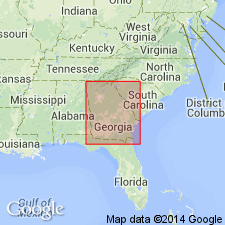
- Usage in publication:
-
- Chickamauga Group
- Modifications:
-
- Revised
- AAPG geologic province:
-
- Appalachian basin
Summary:
Raised the Chickamauga to the Chickamauga Group in GA. Consists of the Lenoir Limestone, Rockmart Slate, Athens Shale, Holston Limestone, Chota Formation, Bays Formation, Moccasin Limestone, Ridley Limestone, Murfreesboro Limestone, and Sequatchie Limestone.
Source: GNU records (USGS DDS-6; Reston GNULEX).
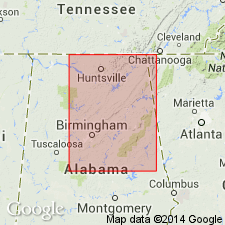
- Usage in publication:
-
- Chickamauga Limestone
- Modifications:
-
- Biostratigraphic dating
- AAPG geologic province:
-
- Appalachian basin
Summary:
The age of the Chickamauga Limestone in AL ranges from latest Chazyan or earliest Blackriveran to middle or late Trentonian (Shermanian or Kirkfieldian). Although the base of the unit has been considered of Blackriveran age, conodonts suggest that the base may locally be as old as Chazyan.
Source: GNU records (USGS DDS-6; Reston GNULEX).
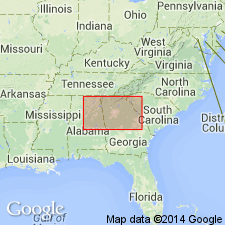
- Usage in publication:
-
- Chickamauga Group*, Supergroup*
- Modifications:
-
- Revised
- AAPG geologic province:
-
- Piedmont-Blue Ridge province
- Appalachian basin
Summary:
The Chickamauga Group in the Chickamauga terrane in AL includes, ascending, the Stones River Formation and its Attalla Chert Conglomerate Member, Nashville Formation, Inman Formation, and Leipers Limestone. These names are used as defined by Drahovzal and Neathery (1971). The Chickamauga Supergroup in the Chickamauga terrane in GA includes, ascending, the Stones River Group and its Pond Spring Formation, Murfreesboro, Ridley, Lebanon, and Carters Limestones, and the Nashville Group and its Hermitage Formation, Cannon Limestone, and Catheys Formation, as used by Milici and Smith (1969). In the Kingston and Clinchport thrust sheets the Greensport Formation and Colvin Mountain Sandstone of Neathery (1986) are adopted and assigned to the Chickamauga Group in AL and Supergroup in GA. Unconformably overlies the Knox Group in GA or the Lenoir Limestone in AL. Underlies the Sequatchie Formation. Age is Middle and Late Ordovician.
Source: GNU records (USGS DDS-6; Reston GNULEX).
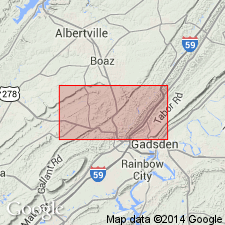
- Usage in publication:
-
- Chickamauga Limestone
- Modifications:
-
- Revised
- AAPG geologic province:
-
- Appalachian basin
Summary:
Chickamauga Limestone, as defined here, includes only rocks of Middle Ordovician age. Chickamauga, above the Attalla Chert Conglomerate Member, is divided informally into Units I and II. Unit I contains carbonate rocks and two distinctive bentonite beds and includes lithologies similar to those of the Murfreesboro, Ridley, Lebanon, and Carters Limestones of the Stones River Group of TN. Unit II includes lithologies similar to those of the Hermitage Formation and Cannon Limestone of the Nashville Group of TN. Chickamauga Limestone underlies Upper Ordovician strata equivalent to Inman Formation.
Source: GNU records (USGS DDS-6; Reston GNULEX).

- Usage in publication:
-
- Chickamauga Limestone
- Modifications:
-
- Mapped
- AAPG geologic province:
-
- Appalachian basin
Summary:
Chickamauga Limestone mapped in Roane Co., eastern TN. Consists of light- to medium-gray and dark-gray, cryptocrystalline to coarsely crystalline, thin- to medium-bedded limestone. Unit is fossiliferous. Argillaceous shale beds are present locally. Shaly limestone is abundant. Contains two or more 1- to 3-foot layers of bentonite in upper half. Thickness reaches 1250 ft in study area. Unconformably overlies Knox Group and underlies Sequatchie Formation. Age is Middle Ordovician.
Source: GNU records (USGS DDS-6; Reston GNULEX).
For more information, please contact Nancy Stamm, Geologic Names Committee Secretary.
Asterisk (*) indicates published by U.S. Geological Survey authors.
"No current usage" (†) implies that a name has been abandoned or has fallen into disuse. Former usage and, if known, replacement name given in parentheses ( ).
Slash (/) indicates name conflicts with nomenclatural guidelines (CSN, 1933; ACSN, 1961, 1970; NACSN, 1983, 2005, 2021). May be explained within brackets ([ ]).

